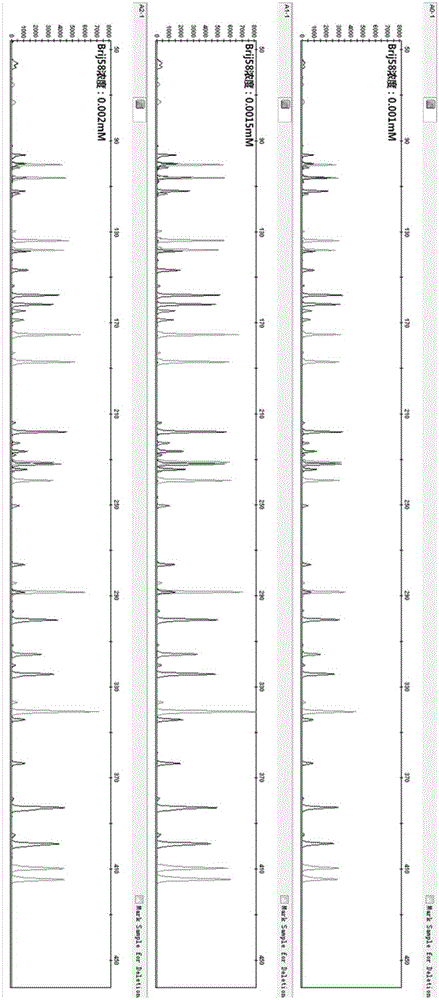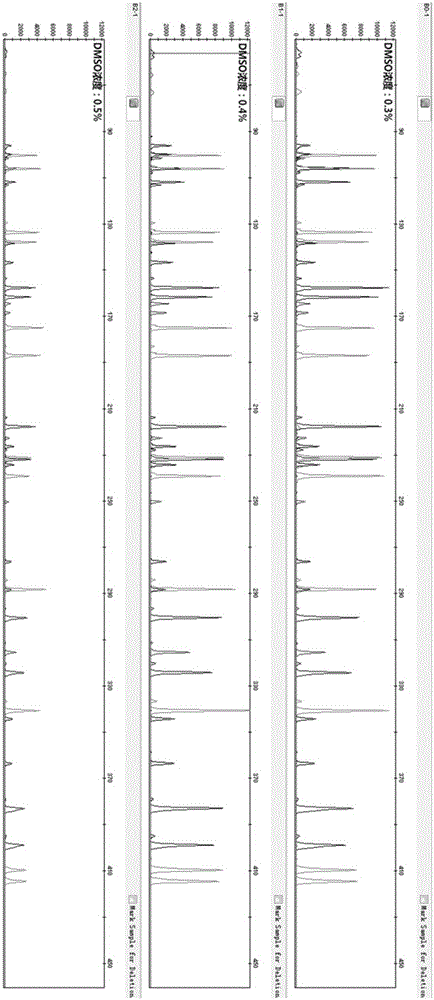Human X-chromosome composite amplification system composed of 20 short serially-connected repetitive sequences and applications thereof
A compound amplification system and short tandem repeat technology, applied in the field of biotechnology and biotechnology, can solve the problems of genetic polymorphism, individual identification and lack of accuracy of detection, etc.
- Summary
- Abstract
- Description
- Claims
- Application Information
AI Technical Summary
Problems solved by technology
Method used
Image
Examples
Embodiment 1
[0074] Example 1 Design of multiplex amplification system for 20 short tandem repeat sequences of human chromosome
[0075] 1. Primer Design
[0076] The primers are designed using software such as PrimePremier5 and NCBIBlast. When designing the primers, it should be ensured that the Tm value of each primer is within the range of (60 ± 2) °C, the amplification efficiency is close, and the amplification products of each pair of primers are different in size. Sufficient to distinguish in capillary electrophoresis. After the design is completed, use software such as AutoDimer to analyze the interaction between the primer dimer and different primers. If there is an interaction that can produce non-specific products or dimers, it needs to be redesigned until the primer sequence that meets the requirements is obtained.
[0077] Select the human DNA template, use the above 20 pairs of primers to carry out single-plex amplification, place the amplified products on 1.5% agarose gel el...
Embodiment 2
[0085] Example 2 Genotyping detection of a certain sample
[0086] 1. Collection of blood samples (blood samples are donated by volunteers)
[0087] 2. DNA extraction
[0088]Use the Chelex-100 method to extract genomic DNA (refer to "Forensic DNA Protocol". HumanaPress, 1998). Take 0.5-5 μl of anticoagulated whole blood or (1-3mm)*(2-5mm) blood spots in a 500 μl centrifuge tube, shake and mix Homogenize the Chelex solution to fully suspend the Chelex, add 195 μl Chelex-100 (5%) solution and 5 μl proteinase K (20 mg / ml) to each tube, shake and mix, keep warm at 56 degrees Celsius for two hours or overnight, take it out and shake for 2 minutes, heat in boiling water for 10 Minutes later, centrifuge at 13000 rpm for 5 minutes, and carefully pipette 150 μl of the supernatant into a new centrifuge tube.
[0089] 3. Reaction system
[0090] Shake and mix each reaction reagent (buffer, primer mix, genomic DNA, etc.) and make a PCR reaction mixture in the following manner. The tot...
Embodiment 3
[0102] Embodiment 3 is aimed at the optimization experiment of enzyme reaction buffer (2.5*BufferD)
[0103] The concentration gradient of KCl in the enzyme reaction buffer is: 0.075M, 0.1M, 0.125M three concentration gradients. MgCl 2 The concentration gradient of the enzyme reaction buffer is: 1mM, 1.5mM, 2mM three concentration gradients. The concentration gradient of Brij58 in the enzyme reaction buffer is: 0.001mM, 0.0015mM, 0.002mM three concentration gradients. The concentration gradient of DTT in the enzyme reaction buffer is: 0.015M, 0.02M, 0.025M three concentration gradients. The concentration gradient of Betaine in the enzyme reaction buffer is: 0.05M, 0.1M, 0.15M three concentration gradients. The concentration gradient of DMSO in the enzyme reaction buffer is: 0.3%, 0.4%, 0.5% three concentration gradients. The concentration gradient of MRTaqⅡ in the enzyme reaction buffer is: 0.15U, 0.25U, 0.35U three concentration gradients. Orthogonal experiments with dif...
PUM
 Login to View More
Login to View More Abstract
Description
Claims
Application Information
 Login to View More
Login to View More - R&D
- Intellectual Property
- Life Sciences
- Materials
- Tech Scout
- Unparalleled Data Quality
- Higher Quality Content
- 60% Fewer Hallucinations
Browse by: Latest US Patents, China's latest patents, Technical Efficacy Thesaurus, Application Domain, Technology Topic, Popular Technical Reports.
© 2025 PatSnap. All rights reserved.Legal|Privacy policy|Modern Slavery Act Transparency Statement|Sitemap|About US| Contact US: help@patsnap.com



